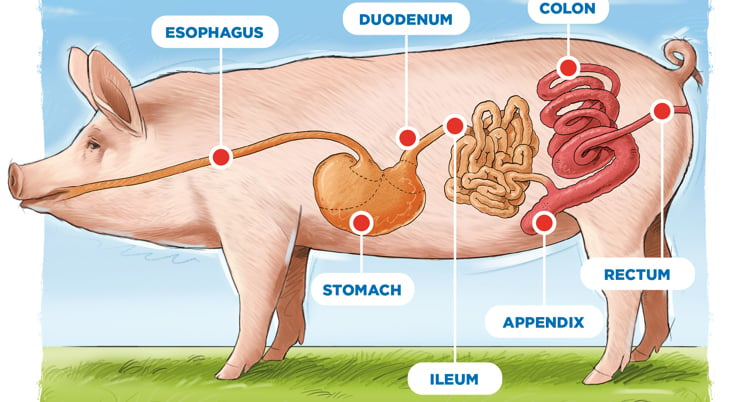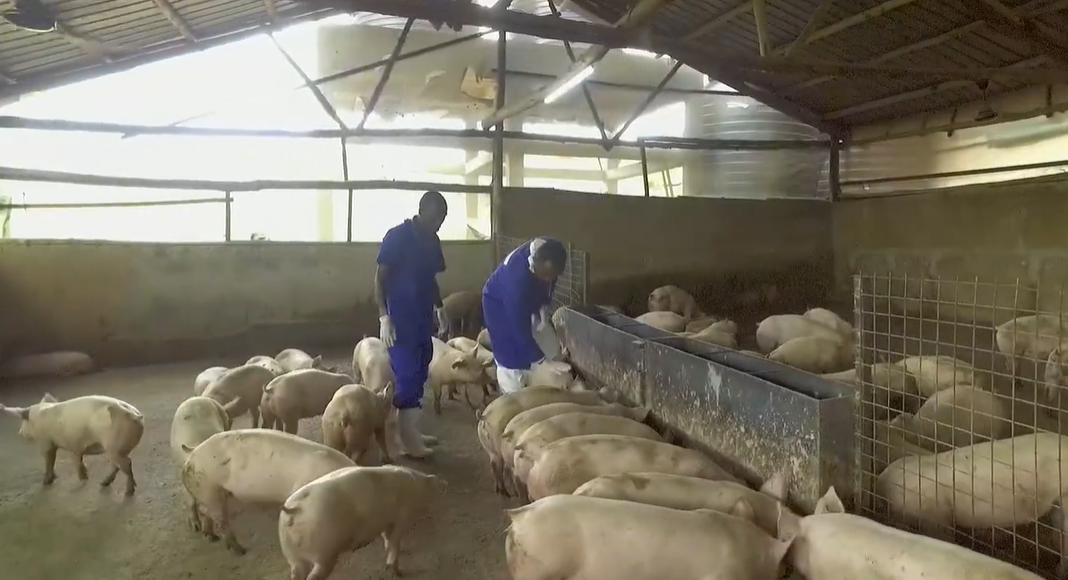The pig’s digestive system explained
Focusing on the intestinal health of pigs is important. A healthy gastrointestinal tract allows pigs to utilize their food efficiently, promoting optimal growth and enabling them to raise many piglets. Healthy intestines also contribute to strong limbs, optimal immunity, and overall well-being. In this article, we explain how the digestive system of pigs works.

The main parts of the gastrointestinal tract are the mouth, stomach, small intestine, and large intestine, as shown in Figure 1. The gastrointestinal system is still developing after birth. Piglets in the farrowing pen are primarily focused on digesting milk. The stomach and intestines continue to develop to process solid food as well. The large intestine, in particular, continues to grow for some time, enabling older pigs to digest fibers better. That is why we have developed different types of feed for various stages of development.
Mouth
The mouth is an important part of feed digestion. Here, the feed is prepared for its journey through the gastrointestinal tract. Chewing grinds the feed particles finer and mixes them with saliva. Saliva contains various substances and enzymes, that start breaking down fats and starches and have antibacterial properties.
Stomach
The pre-chewed feed enters the stomach via the esophagus. The stomach is a sort of vat where the feed is further prepared for digestion. Stomach acid plays a crucial role in this process. The upper part of the stomach receives the swallowed feed and is not very acidic. This part of the stomach lacks a protective layer, making it susceptible to ulcers due to stress, too fine feed, or irregular feed intake.
Deeper in the stomach, there are stomach acids and digestive juices. Here, the stomach mixes and kneads the acidic food mass, beginning the breakdown of proteins. The longer the feed stays in the stomach, the lower the pH can get (more acidic), improving pre-digestion. This also better combats pathogenic bacteria. Since acidifying stomach acid is a challenge for young piglets, we take this into account in our feed composition.
The stomach function depends on the quality of the feed
For proper stomach function, it's important that the feed is fine enough but also contains some coarse fibers. These fibers ensure that the watery, acidic food mass from the robust lower part of the stomach does not enter the sensitive upper part. Koudijs uses the right grind sizes and fibers in its concentrates to prevent stomach ulcers.
With the right type of concentrate, the right processing, and the right nutrients, Koudijs ensures that your pigs' gastrointestinal system functions optimally at every stage
Once the stomach has done its preliminary work, it gradually releases the acidic food mass into the small intestine. Now it's time for the real work. In the first part of the small intestine, the duodenum, the pancreas releases sodium bicarbonate to neutralize the acidic mass. Additionally, a cocktail of enzymes is released here to further digest the feed. The gallbladder adds some emulsifiers to facilitate fat breakdown.
Digestion
Then follows the long journey through the small intestine, which can be up to 20 meters long in adult pigs. Peristaltic (squeezing) movements push the food mass further along the intestine. Meanwhile, digestive enzymes break down the nutrients into smaller and smaller pieces. When they are small enough, they are absorbed into the body through the intestinal wall. To expand the surface area for nutrient absorption to the size of a tennis court, the intestine has many folds and finger-like projections: villi and microvilli, as shown in image 2.
Intestinal damage
In case of illness, intestinal problems, or (weaning) stress, the intestinal villi get damaged and can absorb less nutrients. These undigested residues then enter the large intestine, causing problems. The intestines can also start 'leaking,' allowing harmful substances into the bloodstream, leading to infections (such as edema disease), biting problems, and performance issues.

Tutorials about all essential aspects of pig management
Large intestine
The large intestine's job is to finish the work. Here, the watery remnants that couldn't be digested in the small intestine end up. Ideally, these are mainly fibers, like the hard outer shells of sunflower seeds and grain husks.
Bacteria in the large intestine break down these remains into volatile fatty acids. This process is called fermentation. Fiber fermentation is very healthy for pigs and even provides a bit of energy. The older the pig, the larger its large intestine and the better it can ferment fibers.
The large intestine determines the manure consistency
Besides clearing undigested residues, the large intestine's task is to extract excess water and useful salts from the intestinal content. If small intestine digestion has been optimal, almost no undigested material ends up here, which means no proteins or complex sugar compounds that can attract water. This results in nice, dry manure from the animal.
